













Amicapsil’s effect on pressure injuries
Download Publication
Download Publication
Both studies find 100% closure rates
for acute and chronic pressure injuries
Effective on antibiotic and antiseptic resistant wound infections.
Effective in immunocompetent and immunocompromised persons.
NH ( patient)
NH ( patient)
NH ( patient)
Only natural ingredients
Only natural ingredients
Only natural ingredients
One course of antibiotic release the same amount of carbon as a car driving around Earth 1.47 times.
VH (patient)
VH (patient)
VH (patient)
it is biologically recyclable and does not require the use of chemicals, plastics or antimicrobials.
Hidradenitis suppurativa
Hidradenitis suppurativa (HS) is a chronic condition that can be very painful and have a huge impact on the day-to-day life of the affected individual. It occurs mainly in the armpit (axillae), groin, anal, and breast regions.
In HS, hair follicles get obstructed (occlusion), and infection develops creating a blackhead / comedone or a boil / papule / postule. The pressure of the infection causes the hair follicles to rupture – not to the skin surface but laterally – causing painful, reddish nodules and pus-containing cavities to form under the skin (abscesses). Abscesses may rupture through the skin and drain its pus-containing contents onto the skin surface. The created wound needs to heal. Antibiotics have only limited effects on these infections and the healing is often associated with extensive scar formation. New abscesses causing new wounds are likely to develop adjacent to the initial nodules. As the condition progresses, these abscesses may become interconnected with tunnels running under the skin and deep abscesses may drain their content to the body surface through abnormal tunnelling (sinus tracts), complicating the condition further. As HS is a chronic condition, repeated haling and recurrences leave progressive scarring which complicates future healing, and which can potentially impact the mobility in the area.
The exact underlying cause of HS is unknown, but both genetic and environmental factors seem to be involved. Recently it has been established that HS is associated with an unusually reduced microbiome. The biofilm in HS affected areas is thinner than usual and it contains fewer bacteria1 and the composition of microbes shows differences to what is usually seen in healthy comparable individuals2.
MPPT (Aprobaxil) removes wound infections by optimising the microbiome through its support of the immune system. Therefore, when the boils and abscesses rupture creating an opening in the skin, MPPT will help getting the infection under control and the healing process underway. The quicker an outbreak is controlled, the less tunnelling the infection will be able to create and the less scar tissue is formed.
In cases where the HS reaches a stage that requires surgery, MPPT can help considerably. Once an abscess has been surgically cleaned (debrided), the principal objective is to avoid a return of the infection and to quickly fill the wound with new tissue (granulation) and subsequently to cover the area with new skin (epithelialisation). These are the main clinical outcomes of the use of Aprobaxil. It is encouraged to initiate Aprobaxil therapy on the site as soon as bleeding has stopped. In severe cases, the aim of the surgery is to open all abscesses, ducts tunnels and any other cavity containing infection and clean out as thoroughly as possible. Again, in order to provide the best possible support to the healthy tissue that has been exposed by the surgical procedure, it is important to start the MPPT therapy immediately following surgery.
The most severe cases – often associated with inflammation present or in the past – are sometimes treated surgically by removing the entirety of the skin in the affected area and replacing it with a skin graft from a different part of the body. Even here, Aprobaxil, along the borders of the graft and on any part of the wound surface not covered with new skin, will help prevent any infection and support the granulation tissue required to fasten the graft.
Hidradenitis Suppurativa is classified in 3 clinical stages. A cure does not exist, and the disease will eventually follow its course. It is therefore important to keep the infection, consequential spread and tunnelling and subsequent scarring at a minimum in order to avoid the condition becoming extensive and potentially disabling.
Pain, odour and exudate are symptoms of infection.
If the infection can be removed these issues will disappear. The removal of an infection reduces the risk of tract formation.
Infection increases the degree of scarring.
The faster an infection is brought under control, the less scarring will occur.
HS patients show a very high level of antibiotic resistance.
This is revealed in a study from 2018 which includes first and last resort antibiotics used in HS. The level of resistance in pateints to specific antibiotics ranged from 65% to 89%, depending on the type of antibiotic.
A young woman from Sweden with HS used MPPT (Aprobaxil) on three ulcers on her back and in the groin. She sent us these two statements:
“I apologize for my tardy reply! I managed to get an infection, became rather depressed and everything was at a standstill for awhile. The good news is Aprobaxil worked wonders and I am currently not even wearing a gauze. Today I have enjoyed a three hour walk with my dog for the first time in months. It truly feels like a miracle.
I am forever in your gratitude for making Aprobaxil available to me. I am convinced that, if made easily accessible, it will save lives!(..As well as the publicly financed healthcare-budget.)” ST
“I told him [my dermatologist] about Aprobaxil and showed him pictures of the ulcers (before and after). I showed him the scaring I have from previous wounds compared to whats left of the ulcers where I have used Aprobaxil . Where I have used Aprobaxil the scaring (or soon to be scars) is flat against the surrounding skin, whereas the older scars are bulging/hypertrophic.” ST
Hurley stage 1
Single or multiple abscesses without sinus tract formation or scarring. Early symptoms, such as itching or discomfort, may precede the condition’s characteristic manifestations. Hurley stage 1 is the most common.
Hurley stage 2
Recurrent abscesses with one or more sinus tracts and scarring, widely separated by normal skin.
Hurley stage 3
Diffuse or near-diffuse involvement or multiple interconnected tunnels, sinus tracts and abscesses are observed across the entire area, with scarring and no intervening normal skin.
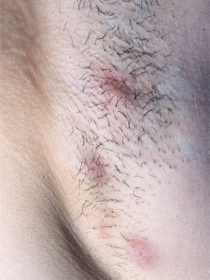
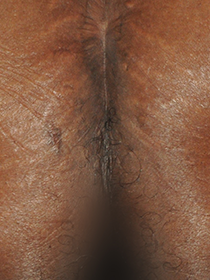
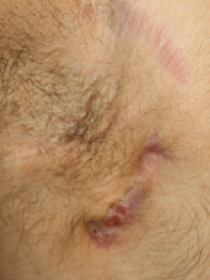
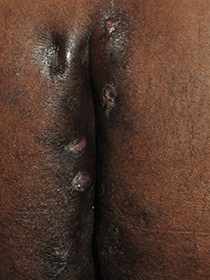
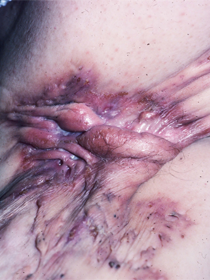
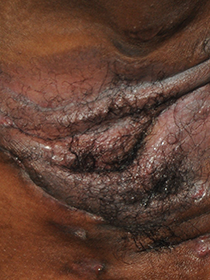
When mild cases are included, HS affects approximately 1% of the population; females more often than males. It usually appears during puberty and almost never after the age of 40.
